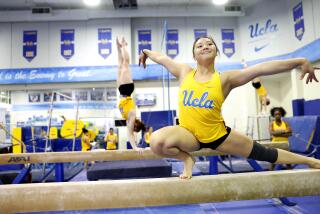Gretchen Bleiler, back from freak accident, has Sochi in her sights
Her pursuit of perfection simply had to be steered in another direction, rechanneled into the offices of numerous doctors and countless hours of physical therapy.
U.S. Olympic snowboarder Gretchen Bleiler was staring at the most significant challenge of her life, regaining full vision after a freak training accident on a trampoline resulted in a broken right eye socket, a fractured nose and concussion.
This occurred in June 2012, more than six years after Bleiler stood on the podium at the Olympics in Turin, Italy, with a silver medal around her neck. Suddenly, an Olympic bid in Sochi, Russia, was secondary to her ability to see.
“Honestly, it was such a bad accident, that I wasn’t even thinking about snowboarding,” Bleiler said. “I wasn’t thinking about the Olympics, I was just thinking about getting better and physically feeling better, being able to see again.”
The affable Bleiler, 32, a magazine cover model with her own clothing line, has been sharing her story of continuing recovery since the accident. In fact, there is a compelling video on YouTube about the process, via Muscle Milk’s home page, including her experimental work with physical therapist Brad Jones of b Project in Carlsbad.
On this particular occasion, she was talking with a handful of reporters in Park City, Utah, months before the final series of Olympic qualifiers. Bleiler revealed that her vision was still not quite the same as it was before the accident.
“My vision is different from what it once was,” she said. “It’s not the same … [but] it’s not holding me back any longer. When I had my accident before I had my surgery, my surgeon told me there was a possibility I would have double vision for the rest of my life with my upglance.
“And I still have double vision with my upglance. It’s so subtle, but just tilting my head a little bit up will fix the problem.”
Even before the accident, making her third Olympic team was never going to be an effortless assignment because of the deep reservoir of talent among the female riders in the United States.
“The girls are the Dream Team,” said Mike Jankowski, the U.S Olympic head halfpipe coach, in 2010.
That statement still holds true four years later. At the Vancouver Games, she was one of the gold-medal favorites but finished 11th. The gold medal went to an Australian, Torah Bright, but silver and bronze went to American snowboarders, Hannah Teter and Kelly Clark.
Clark, who turned 30 in July, already secured a trip to Sochi by winning the second Olympic qualifier, the U.S. Grand Prix at Copper Mountain Resort in Colorado. This will be her fourth trip to the Olympics; she won halfpipe gold at the 2002 Games in Salt Lake City.
The women and men — as well as the free skiers — are competing at the third qualifier, in Breckenridge, Colo. The journey to Sochi for Bleiler, who was third in the standings before Breckenridge, got a bit more complicated when she failed to advance out of qualifying on Wednesday. Finals are Saturday.
There are three guaranteed Olympic slots for the female snowboarders and possibly one more, depending on several factors.
Observers said that conditions were challenging during qualifying runs at Breckenridge because of snow falling throughout the day, complicating conditions in the flat bottom of the halfpipe. This hurt Bleiler’s efforts to pick up enough speed in the halfpipe to pull off her usual array of tricks.
The top qualifier Wednesday and snowboarder generating the most buzz, happens to be a youngster who is still three years away from being eligible to get her driver’s license.
Not only is 13-year-old Chloe Kim too young to drive, she will be too young to compete in Sochi. She was born in Long Beach and has trained in Switzerland and Mammoth and doesn’t turn 14 until April.
Bleiler will have two more events later this month, both scheduled for Mammoth, to make the squad. For her, simply being able to compete again is nothing short of incredible.
“It was a pretty uncommon accident,” she said. “And so there wasn’t somebody I could talk to and say, ‘How long did it take you? And what were the steps?’ I was just kind of feeling around in the dark.”
It helped that Jones and Bleiler had a long history of working together. He designed an unconventional program, suggested that she try eye exercises while in motion. They both learned along the way and the proactive approach appealed to Bleiler.
“I felt like we were sort of breaking ground on new territory what I could find out there,’” Jones said in a telephone interview. “How do you approach this? Where can we take it?
“Luckily for us, everything fell into place and we just saw progression after progression and got her back to doing what she loves to do. When it responded right away, it was like, ‘OK, we’re on the right track.’
“Her plane of vision has to be as large as possible to where she can’t have any limitations there. That was one of the things that really wasn’t talked about, at least initially. This is an important component for her.”
They refused to be passengers, settling in for the ride.
“Unless you train for it, like why would you expect it to come back?” Jones said. “That the thing I was looking at, ‘We just can’t wait for it to come back.’ We have to train for it to get it back.
“That’s what rehab is — it’s not just going to happen on its own.”
Twitter: @reallisa
More to Read
Go beyond the scoreboard
Get the latest on L.A.'s teams in the daily Sports Report newsletter.
You may occasionally receive promotional content from the Los Angeles Times.







